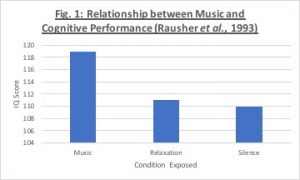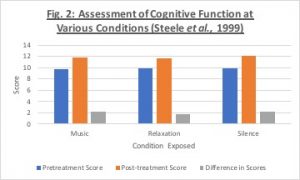Rausher, Shaw and Ky‘s 1993 paper in Nature, showing correlation of increase cognitive function and exposure to Mozart’s piano music, triggered a worldwide interest in developing new technology to improve learning. Government and private corporations invested large sums of money to develop Mozart-based learning tools to improve the intelligence of students.
Rausher et. al original study recruited college students to partake in a standardized cognitive test that extrapolated to an IQ score. Students were allowed to complete the test in one of three conditions that were assigned to them: with Mozart’s Sonata in D major, K 448 playing, with relaxing music playing in background, in silence. Rausher’s data (Fig. 1) astonished the world, when students completing the test with Mozart’s sonata playing were found to have a higher IQ score than those under the other conditions.

Data first appeared in the paper, re-presented in graph form for clarity.
Critics of Rausher questioned the validity of the data collected in the study. Kenneth Steele of Applachian State University questioned effects of bias due to the small sample size of the initial study and indirect comparison to a control group on the data. Steele et al. adapted Rausher et al.‘s methodology to study changes in the cognitive performance college students when exposed to music by Mozart, Phillip Glass (minimalist music empirically shown to have opposite effect of Mozart’s music) and silence. Steele et al. tested all participants before (pre-treatment) and after/during (post-treatment) exposure (Fig. 2) and found no significant difference between improvements in the scores of students exposed to Mozart, in comparison to the other groups.

Graph created from data presented in Steel et al.’s 1999 paper
Whether or not Mozart’s music can increase cognitive performance remains actively debated in scholarly communications, where Rausher and Steele have both continued to publish articles arguing for and against the existence of the Mozart effect. Elsewhere, Rausher et al.‘s 1993 study has inspired applications of Mozart’s music in patients with epilepsy Considering that the original music inspiring this research is over 220 years old, who knows what the future applications of Mozart’s masterpieces might be.
Aydan Con
PS: I don’t have permission to use a recording of the above mentioned Mozart Sonata, and my own recording of the work is not available at the time of this blog. Instead, I have posted a performance of another work associated with the Mozart Effect, Piano Concerto in A major, K. 488. The performance is by pianist Natalie Lo (BMus ’16) with the UBC Symphony Orchestra conducted by Dr. Jonathan Girard (used with permission).

2 responses to “Reality Check: Mozart Effect vs. Science”